Please note: You are viewing
the unstyled version of this website. Either your browser does not support CSS
(cascading style sheets) or it has been disabled. Skip
navigation.
Biology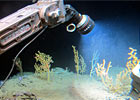 Alvin and Sentry explore the deep Gulf
Alvin and Sentry explore the deep GulfPrincipal Investigator: Tim Shank In December 2010, R/V Atlantis carried the submersible Alvin and autonomous underwater vehicle (AUV) Sentry to the Gulf of Mexico to help scientists examine deep-sea habitats near the source of the oil spill. Use of the two vehicles in tandem to identify and target sites of interest on the seafloor represented a first for deep-water exploration. 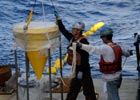 Collecting Deep-sea Sediment
Collecting Deep-sea SedimentPrincipal Investigator: Chris German In late 2009, a group of researchers studying deep-water animals and habitats in the Gulf of Mexico set out two instruments to collect samples of the carbon-rich debris that rains down from above and that serves as food for many of the animals that live on the bottom. Both were scheduled to take their final sample on July 2 so WHOI researchers quickly mobilized to place new instruments on the seafloor and extend their record of conditions in the Gulf. 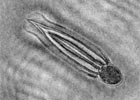 From Plankton to Oil Droplets
From Plankton to Oil DropletsPrincipal Investigators: Cabell Davis, Nick Loomis WHOI scientists deployed instruments specially designed to identify and measure the tiny plants and animals that live in the open ocean. At the same time, they discovered that their instruments are also well suited for measuring the size and distribution of oil droplets in the water column. This information is important to model the oil plume more accurately. 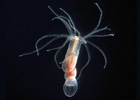 Biological Responses to Oil and Dispersant
Biological Responses to Oil and DispersantPrincipal Investigator: Ann Tarrant Based on a long history of work with the starlet anemone (Nematostella vectensis), scientists from WHOI and elsewhere have begun watching for and modeling genetic and physiological responses in the organism to the oil and the dispersants used to fight the spill. 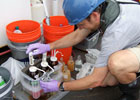 Dead Zones and Microbial Response to Oil
Dead Zones and Microbial Response to Oil Principal Investigator: Ben Van Mooy Water samples from the Gulf are helping scientists understand how different microbes in the ocean respond to oil spills. They found that although oil-eating microbes were limited by a lack of phosphorous in the water, they were able to consume oil at a much higher rate than expected. Chemistry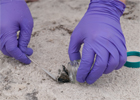 Gulf Coast Sample Repository
Gulf Coast Sample RepositoryPrincipal Investigator: Chris Reddy Following the Deepwater Horizon oil spill, many Gulf coastal beaches were oiled. Some remnants of this oil remain and provide invaluable clues on the fate of oil in the marine environment. To track such changes, samples are being collected and photos of the samples are available on a website to facilitate requests for material. 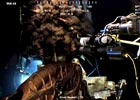 Collecting Underwater Oil Samples
Collecting Underwater Oil Samples Principal Investigators: Chris Reddy, Jeff Seewald Before scientists could calculate the amount of oil flowing into the Gulf, they needed to know the composition of the material gushing from the ruptured wellhead. To obtain this crucial sample, WHOI scientists used a device originally built to study hydrothermal vent fluids to capture and contain the oil and gas at pressure and then transport it back to the lab for analysis. 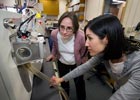 Analyzing Gulf Water Samples
Analyzing Gulf Water SamplesPrincipal Investigator: Liz Kujawinski Oil is a complex mixture of up to 100,000 compounds, some soluble in water, some not. Once it enters the environment, particularly the ocean, it begins to fractionate and no longer acts as a single substance. WHOI chemists have developed finely tuned analytical instruments and techniques to track minute amounts of the soluble components of oil in the Gulf, as well as faint chemical traces of the dispersants used to break up the spill. Circulation & Transport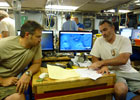 Mapping and Characterizing an Underwater Plume
Mapping and Characterizing an Underwater PlumePrincipal Investigator: Rich Camilli WHOI scientists deployed the autonomous underwater vehicle (AUV) Sentry equipped with a compact, underwater mass spectrometer to identify and map the chemical plume spreading from the blown-out oil well. The techniques they used were developed at WHOI to find hydrothermal vents and underwater volcanoes. 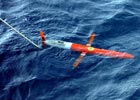 Mapping Gulf Currents
Mapping Gulf CurrentsPrincipal Investigator: Breck Owens In the weeks after the Gulf oil spill started, WHOI scientists and their colleagues deployed an autonomous underwater vehicle called a Spray glider to map currents in the Gulf of Mexico from June to August. These measurements helped predict the spread of the oil at and beneath the surface and to alleviate fears that the oil would spread far beyond the Gulf. 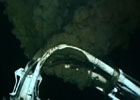 Calculating Flow Rate
Calculating Flow RateDeepwater Horizon, 2010 Principal Investigators: Rich Camilli, Andy Bowen In the early weeks after the explosion of the Deepwater Horizon drill rig, estimates of how much oil was pouring into the Gulf varied widely. A reliable figure was crucial to helping everyone involved in battling the spill understand what they were up against. Last updated: July 28, 2014 | |||||||||||
Copyright ©2007 Woods Hole Oceanographic Institution, All Rights Reserved, Privacy Policy. | |||||||||||

